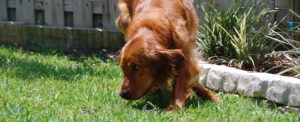Helping Fearful Dogs
By Susan Kendrick – CPDT – KA Bowser College
Email: info@bowsercollege.com
Web: www.bowsercollege.com
My dog is afraid of other dogs or people
My dog is afraid of storms
My dog has separation anxiety
Fear is as real to a dog as it is to us. What is your fear? Spiders, snakes, tight spaces? Fear is not silly and it is not something a ‘correction’ or ‘training’ will fix. Fear can be actual things – such as garbage cans, bicycles, and tall, deep voiced men – or they can be events, such as being left alone, riding in a car, or experiencing July 4th fireworks. These things or events are called ‘triggers’ and are what sets fear in motion.
Debbie Jacobs, behavior and training guru who has helped thousands of fearful dogs said this, “We all know individuals with a ‘martyr’ mentality who will act fearful and helpless just to get attention and have others take care of them. This doesn’t seem to be true for animals. They don’t pretend. If they don’t feel afraid, they don’t act afraid.” Her website has great information on helping fearful dogs.
Know this: When a dog’s emotional state changes, so does his behavior. As Jacobs points out, “One of the quickest ways to get your dog not to trust you is to override his telling you that he does not feel safe.”
Often times, people are surprised that their dog is showing signs of fear. To the human, it might make no sense. To the dog, one life event – whether it happened during puppy development – which is called the critical fear period or because of a life event later, the dog is fearful of something.
that their dog is showing signs of fear. To the human, it might make no sense. To the dog, one life event – whether it happened during puppy development – which is called the critical fear period or because of a life event later, the dog is fearful of something.
One of the reasons I became intrigued with understanding the psychology behind a dog’s fear was because of our own adorable, one year old Jackson. Jackson was such a happy, typical young dog and yet, we quickly realized that he had a deathly fear to a flashlight. Just catching sight of it, not even turned on, sent him into a small ball of fear. As it turned out, the person who had rescued him from his ‘home’ – which was nothing other than the back yard – said the owner used to go out at night when the pup was crying and would hit him with the flashlight. No wonder Jackson was fearful of something so innocuous as a flashlight.
Events teach us, and animals, what to expect – and perhaps fear. Think about a dog who was fending for herself as a stray on the streets. Safety and food was a daily competition. This life event could easily lead to the fear of other dogs later in life and to aggressive displays to other dogs – as a way to be safe.
To understand fear, let’s look at a few facts:
• Fear can be learned through an experiences or genetics. Recent scientific studies have concluded that puppies in utero and who are sired by a fearful father or carried by a fearful mother can be born as fearful puppies. This is hard wired.
• Fear is not an issue resolved by ‘training.’ It takes a psychological approach using kindness and behavior modification. When trying to eliminate fear, the goal is to change the emotional state and perception that the dog has about the trigger (what sets him into a fearful state). The goal is to change the dog’s perspective about what makes him fearful. We are working with emotion – not just behavior.
• Fear and displays of aggression 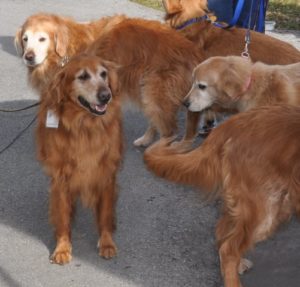 (vs. truly wanting to be aggressive) are closely related. As with humans, dogs will often try to send ‘signals’ – their way of communicating how they are feeling and perceiving things around them. These signs of communication are called ‘calming, deference or stress signals.’ Calming signals are a set of body language skills which dogs use to maintain healthy relationships and resolve conflict without having to resort to aggressive behaviors. These signals often occur early in interactions, as soon as a dog becomes aware that a situation may need “calming down.” This facet of canine communication is designed to help dogs calm themselves and others in the face of stress. Additionally, many dogs make use of calming signals in an effort to simply show goodwill.
(vs. truly wanting to be aggressive) are closely related. As with humans, dogs will often try to send ‘signals’ – their way of communicating how they are feeling and perceiving things around them. These signs of communication are called ‘calming, deference or stress signals.’ Calming signals are a set of body language skills which dogs use to maintain healthy relationships and resolve conflict without having to resort to aggressive behaviors. These signals often occur early in interactions, as soon as a dog becomes aware that a situation may need “calming down.” This facet of canine communication is designed to help dogs calm themselves and others in the face of stress. Additionally, many dogs make use of calming signals in an effort to simply show goodwill.
• ‘Triggers’ are things or events that make a dog fearful and send them into an emotional and physiological change. Fear of spiders? You not only feel the fear in your mind but have physiological changes like a rapid heart rate, more cortisol (the stress hormone) and less oxygen getting to your brain. Dogs have many of the same emotional, chemical and physiological changes when faced with fear. Triggers can be people, other dogs, bicycles, or even manhole covers on the street. What we think is normal may not be perceived that way in the eyes of a dog who, for whatever reason, has grown to mistrust ‘it’ – the trigger.
What not to do:
1. Do not flood your dog with what he fears most – making him ‘face his fears.’ The most damaging thing someone can do is to ‘fix’ fear by flooding the dog with the thing he fears the most. There is an old school theory that if you face your fears; you’ll get over them. It simply doesn’t work and can often make the fear even worse. I recently worked with a client whose dog was fearful of strangers.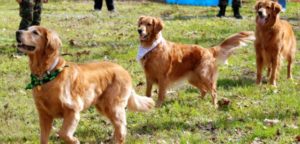 She said, “Don’t you think if we just made her sit her and watch all the strange walkers go by, she’ll figure out that they won’t hurt them?” This is called ‘flooding’ in psychology. I asked her about her own greatest fear. It was snakes. I asked if I ‘made’ her sit on the bench while we paraded snakes by her time and time again, would it help her reduce her perception of snakes?” She got it. Flooding is not only antiquated but often a cruel approach that makes the fear worse – instead of better. Just like with humans, dogs will not learn to overcome fear by making them valiantly face their fears.
She said, “Don’t you think if we just made her sit her and watch all the strange walkers go by, she’ll figure out that they won’t hurt them?” This is called ‘flooding’ in psychology. I asked her about her own greatest fear. It was snakes. I asked if I ‘made’ her sit on the bench while we paraded snakes by her time and time again, would it help her reduce her perception of snakes?” She got it. Flooding is not only antiquated but often a cruel approach that makes the fear worse – instead of better. Just like with humans, dogs will not learn to overcome fear by making them valiantly face their fears.
2. Fear + Punishment = Greater fear and disaster. All avoidable and in your control.
3. Think that the fear will go away. Fear often ‘generalizes’ in dogs – meaning it spreads to other environments. The dog who is fearful of people in hats on a walk will also be equally as fearful of hats in the vet’s office or in your home.
What to do:
1. 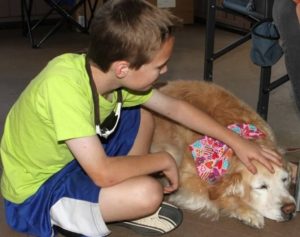 Have patience. Understand that while it may not make sense to you why your dog is fearful of something, that doesn’t mean it isn’t a real concern for your dog.
Have patience. Understand that while it may not make sense to you why your dog is fearful of something, that doesn’t mean it isn’t a real concern for your dog.
2. Use positive associations to what could be ‘triggers’ – but be warned that this is only helpful if your dog is not showing stress signs and is not feeling stressed.
3. Be respectful of their fear – whether you think it’s ‘silly’ or not – and work to change their perception. Here’s a great read by fellow positive trainer, Sam Wike.
4. Don’t hesitate to hire a force-free, positive training professional who is educated in teaching counter conditioning and desensitizing methods. Often times, it helps the human owner as much as the dog to get this right the first time! Check out these great resources for finding Force Free, certified professionals: Pet Professional Guild & Positively.com
Why do dogs become ‘fear aggressive’ – where fear begins to look like real aggression? The root of most aggressive behavior is fear. Combine fear with a situation where a dog has not been raised and trained humanely and the result is often a disastrous cocktail of fear aggression. Owners and trainers who employ punishment-based techniques on the fear aggressive dog frequently make this even worse.
If a fearful dog is put into a situation in which they feel that they have no control, or if they feel that their attempts to signal for help isn’t working, they may feel the need to display aggressive body language. A common, sad and completely avoidable scenario is a dog who wants to be left alone. A child keeps going over to the dog, ‘petting’ (for very young children their motor skills do not result in normal, ‘kind’ petting) the dog. The dog turns his head in avoidance, his ears placed back showing anxiety, and his brow is furrowed. These body language signs tell a story – except a child can’t understand what the dog is desperately saying. The child continues to interact with the dog who then slinks under the coffee table. The child, not knowing any better, follows. The dog begins ‘aggressive’ displays such as growling or showing teeth with ears pinned back. This isn’t necessarily a dog that wants to be aggressive, but instead is just trying to make ‘it’ – the scary thing that triggers fear – go away! The bottom line with fear aggression: If you can predict it, you can prevent it.
Regardless of what fear a dog has, you, the human, have the power 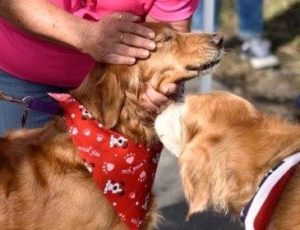 and the choice to help your dog overcome what scares him. Some fears are deep seeded and professional guidance will help you help your dog. Be the person your dog knows you are – patient, kind and willing to show them the light when things seem dark and scary.
and the choice to help your dog overcome what scares him. Some fears are deep seeded and professional guidance will help you help your dog. Be the person your dog knows you are – patient, kind and willing to show them the light when things seem dark and scary.
For more information, please see the Whole Dog Journal article:
How to help you dog through Fireworks and Loud Noises

